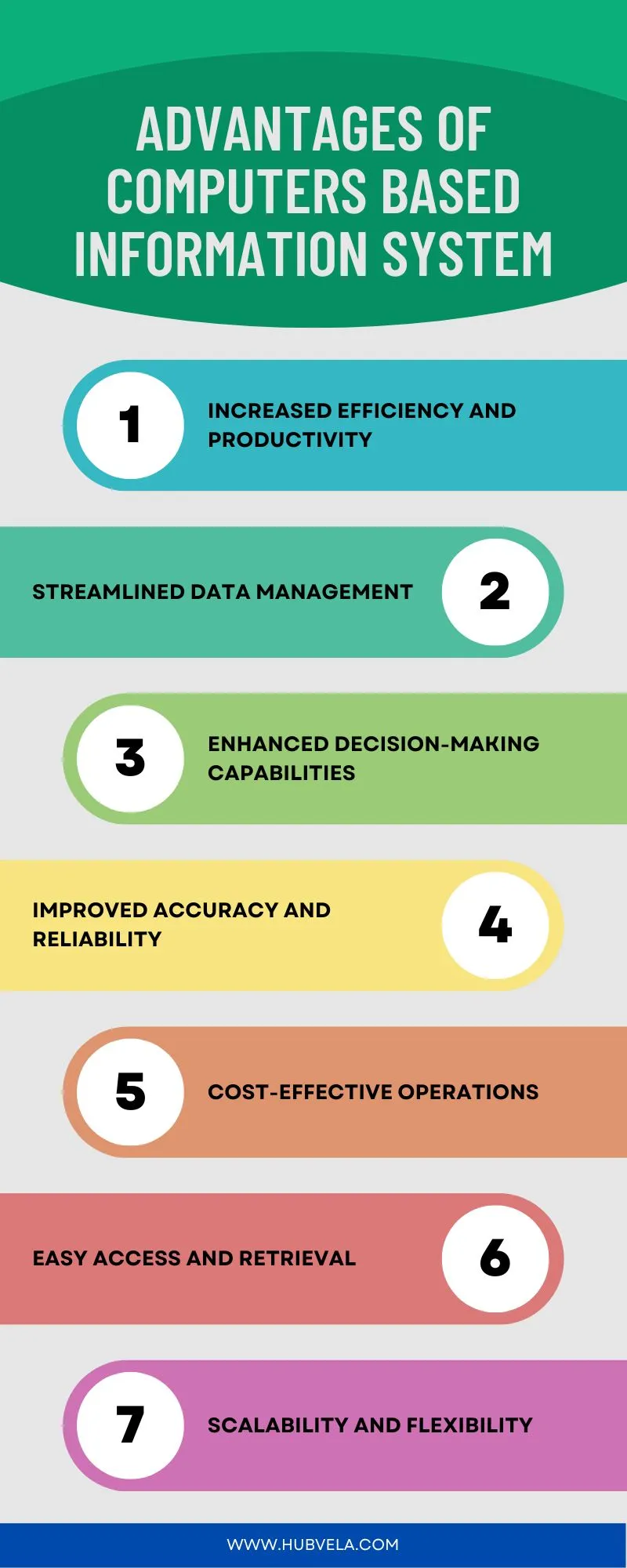Are you curious about the perks and drawbacks of computer-based information systems? Well, look no further! In this article, we will explore the advantages and disadvantages of computers based information systems.
By using computers for managing information, you can experience increased efficiency and productivity, as well as streamlined data management. With enhanced decision-making capabilities, your organization can make better-informed choices. Moreover, computer-based systems offer improved accuracy and reliability.
However, it’s essential to acknowledge that there are a few downsides. These systems heavily rely on electricity, which means any power outage can disrupt operations. Additionally, there is a potential risk of system crashes. Lastly, personalization options may be limited.
So, let’s delve into the world of computer-based information systems to understand their pros and cons in more detail.

--Advertisement--
Advantages of Computers Based Information System
In the modern business landscape, the advantages of computer-based information systems play a crucial role in enhancing efficiency, communication, and decision-making.
These systems have transformed the way organizations operate, offering numerous benefits that include:

1. Increased Efficiency and Productivity
Improving efficiency and productivity is a key advantage of using a computer-based information system. With technological advancements, these systems provide increased productivity and time savings for businesses.
By automating processes and tasks, computer-based information systems enable improved efficiency. Manual tasks that used to take hours can now be completed in a matter of minutes, allowing employees to focus on more strategic and value-added activities. The automation benefits of these systems eliminate human errors and ensure accurate and consistent results.
Additionally, computer-based information systems can handle large volumes of data, analyze it quickly, and generate meaningful insights for decision-making.
2. Streamlined Data Management
To streamline data management, a computer-based information system offers you a more efficient and organized way to handle and store large amounts of data. With the use of advanced technology and software, data storage becomes easier and more accessible. You can store vast quantities of data in a compact space, eliminating the need for physical storage such as filing cabinets or boxes.
Furthermore, a computer-based information system allows for effective data organization. You can categorize and label data, making it easier to locate and retrieve when needed. Additionally, the system enables data analysis, allowing you to extract valuable insights and trends from the data. Integration of different data sources becomes seamless, facilitating a comprehensive view of information.
However, it’s important to prioritize data privacy and security to ensure that sensitive information is protected from unauthorized access.
3. Enhanced Decision-Making Capabilities
With a computer-based information system, you can make more informed decisions by utilizing enhanced data analysis and real-time information. Improved decision making is one of the key advantages of a computer-based information system.
By analyzing data efficiently and accurately, you can gain valuable insights into various aspects of your business. Real-time insights provided by the system allow you to make decisions based on up-to-date information, enabling you to respond quickly to market changes and make timely strategic planning decisions.
Additionally, the system helps in risk assessment by providing data-driven analysis, allowing you to identify potential risks and devise appropriate mitigation strategies.
4. Improved Accuracy and Reliability
You can experience increased accuracy and reliability with a computer-based information system. One of the advantages of using such a system is improved accuracy in data processing. Computers are capable of performing complex calculations and data analysis with precision, reducing the chances of human error.
Additionally, a computer-based information system can enhance reliability by ensuring data integrity and validation. It can automatically validate data input, flagging any inconsistencies or errors that may arise. This helps in maintaining reliable and error-free data.
5. Cost-Effective Operations
One advantage of using a computer-based information system is the cost-effectiveness it brings to your operations. By implementing such a system, you can achieve significant cost reduction in various areas of your business.
With improved operational efficiency, tasks that were once time-consuming and labor-intensive can now be automated, allowing your employees to focus on more strategic and value-added activities.
Resource optimization is another benefit, as the system enables you to effectively allocate and utilize your resources, minimizing waste and maximizing productivity.
Additionally, the availability of accurate and timely information supports improved decision-making, giving you a competitive advantage in the market.
6. Easy Access and Retrieval
Implementing a computer-based information system enhances accessibility and retrieval of data, streamlining your operations and improving overall efficiency. With a user-friendly interface, accessing relevant information becomes more convenient and time-saving. Gone are the days of manually searching through piles of documents or sifting through countless files.
With just a few clicks, you can retrieve the information you need, saving valuable time and effort. The computer-based system allows for easy organization and categorization of data, making it easier to locate and retrieve specific information when needed. Whether you’re searching for customer records, inventory details, or financial data, the system provides quick and efficient access, allowing you to make informed decisions and respond promptly to customer inquiries.
Say goodbye to the hassle of manual data retrieval and embrace the convenience and efficiency of a computer-based information system.
7. Scalability and Flexibility
With a computer-based information system, you can easily scale and adapt your operations to meet the changing needs of your business. However, there are some challenges and limitations that you need to be aware of.
Scalability challenges can arise when your system is unable to handle increased workload or data volume.
Flexibility limitations may occur when your system lacks the capability to incorporate new features or functionalities.
System integration issues can arise when your computer-based information system struggles to communicate and share data with other systems within your organization.
Adaptability concerns may arise when your system can’t easily adjust to changes in business processes or industry requirements.
Lastly, organizational resistance can be a barrier to implementing and utilizing a computer-based information system due to resistance to change or lack of technological literacy.
It’s important to consider these factors when evaluating the scalability and flexibility of your computer-based information system.
Disadvantages of Computers Based Information System
Computer-based information systems (CBIS) have become increasingly popular in various industries, offering numerous advantages such as improved efficiency, data standardization, and cost savings.
However, despite these benefits, there are also disadvantages associated with relying on computerized systems. We will discuss the main drawbacks of computer-based information systems.

1. Cost and Maintenance
Maintaining a computer-based information system can be costly over time. The cost effectiveness of implementing such a system needs to be carefully evaluated.
While technological advancements can bring about improvements in efficiency and productivity, they also introduce new maintenance challenges. Budget allocation becomes crucial in ensuring that the system is well-maintained and updated regularly.
Organizations need to consider the costs associated with hiring skilled IT professionals, purchasing software licenses, and upgrading hardware. Conducting a cost benefit analysis can help determine whether the advantages of the system outweigh the expenses.
It’s important to weigh the initial investment against the long-term benefits and potential drawbacks. While a computer-based information system can provide numerous advantages, it’s crucial to carefully consider the cost and maintenance implications before implementation.
2. Data Security Risks
To understand the disadvantages of a computer-based information system, you must be aware of the data security risks associated with its implementation.
One major concern is the risk of data breaches, where unauthorized individuals gain access to sensitive information.
Cyber attacks are another issue, with hackers exploiting vulnerabilities in the system to gain unauthorized access or disrupt operations.
Privacy concerns arise due to the potential for data leakage, where confidential information is unintentionally exposed.
Additionally, there’s a risk of information theft, where valuable data is stolen and used for malicious purposes.
These security risks pose significant challenges for organizations relying on computer-based information systems, requiring constant vigilance and robust security measures to mitigate the potential harm.
3. Lack of Human Interaction
One major disadvantage of a computer-based information system is the lack of human interaction, which can hinder effective communication and collaboration within an organization.
The absence of face-to-face interaction and social cues in a computer-based system can have significant social implications. Without the presence of direct human interaction, communication may become impersonal and lack the depth and nuance that comes from personal interaction. This can lead to misunderstandings, misinterpretations, and a lack of trust among team members.
In addition, the limitations of computer-mediated communication can result in reduced interpersonal skills, as individuals may rely more on technology rather than developing their communication abilities. Furthermore, the lack of human interaction in a computer-based information system can have psychological effects, such as feelings of isolation, loneliness, and decreased job satisfaction.
4. Technical Glitches and Errors
When dealing with a computer-based information system, you may encounter technical glitches and errors that can disrupt the smooth functioning of the system. These issues can be frustrating and time-consuming, but there are steps you can take to minimize their impact.
First, ensure that you have access to reliable technical support. Having experts available to assist you with any problems can make a huge difference in resolving issues quickly.
Additionally, investing in user training can help prevent errors caused by user inexperience or lack of knowledge.
Regular software updates are crucial as they often include bug fixes and security patches.
It’s also important to regularly back up your data to avoid losing important information in the event of a system failure.
Lastly, familiarize yourself with system troubleshooting techniques to troubleshoot and resolve minor issues on your own.
5. Dependence on Electricity
A major drawback of computer-based information systems is their reliance on electricity. In today’s digital age, we heavily depend on electricity to power our computers and keep our information systems running smoothly. However, this dependence can become a disadvantage when there’s a power outage.
Without electricity, the entire system comes to a halt, resulting in disrupted operations and potential loss of important data. To mitigate this risk, organizations often implement backup systems, such as uninterruptible power supplies (UPS) or generators, to provide temporary power during outages.
Additionally, the reliance on electricity raises concerns about energy consumption and its environmental impact. Organizations are increasingly exploring renewable energy sources to power their information systems, aiming to reduce their carbon footprint and promote sustainability.
6. Potential for System Crashes
You may experience system crashes when using computer-based information systems. These crashes can occur due to various reasons and can greatly impact the stability of the system.
When a system crashes, it can result in potential downtime, leading to a halt in operations and loss of productivity. Moreover, system crashes can also result in data loss, which can be detrimental to the organization’s operations and overall efficiency.
To tackle such issues, it’s important to have troubleshooting measures in place. These measures can help identify the root cause of the crash and resolve it in a timely manner, minimizing the impact on productivity.
Regular system maintenance and backups can also help in preventing data loss and ensuring system stability.
7. Limited Personalization Options
One major disadvantage of computer-based information systems is the limited personalization options available to users. Personalization limitations stem from customization constraints, which result in a lack of individualization and restricted personal preferences.
Users often find themselves unable to adapt the system to their specific needs and preferences, leading to frustration and decreased productivity. The limited user adaptability inherent in computer-based information systems can hinder efficiency and user satisfaction.
Without the ability to customize the system to their liking, users may struggle to navigate through interfaces that don’t align with their preferred workflows or visual preferences. This lack of personalization can also lead to a one-size-fits-all approach, which may not cater to the unique requirements of different users or organizations.
Conclusion on Advantages and Disadvantages of Computers Based Information System
In conclusion, computers based information systems offer numerous advantages that can greatly enhance efficiency and productivity in various industries.
Streamlined data management, enhanced decision-making capabilities, and improved accuracy and reliability are just a few of the benefits that can be achieved.
Additionally, the cost-effective operations, easy access and retrieval, and scalability and flexibility make these systems highly desirable.
However, it is crucial to acknowledge the potential disadvantages that come with computers based information systems. The costs and maintenance required can be significant, and data security risks should be carefully managed to protect sensitive information.
The lack of human interaction and limited personalization options may also be drawbacks for some users. Technical glitches, dependence on electricity, and the potential for system crashes are additional factors that need to be considered.
While computers based information systems have revolutionized the way organizations operate, it is important to weigh the advantages against the disadvantages to make informed decisions.
By understanding and addressing these potential drawbacks, businesses can maximize the benefits and effectively leverage these systems to enhance their overall operations.


